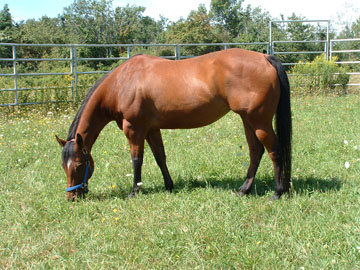|
EQUINE CLICKER TRAINING..... using precision and positive reinforcement to teach horses and people |
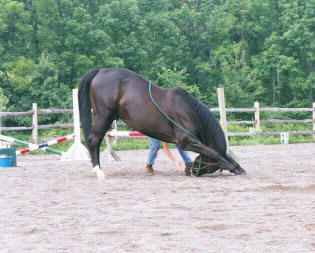
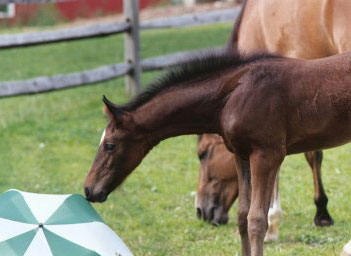
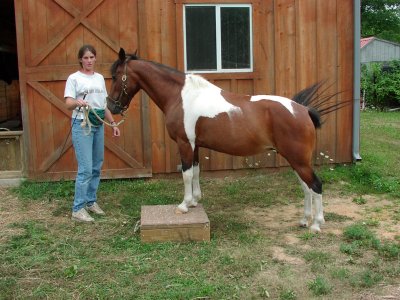
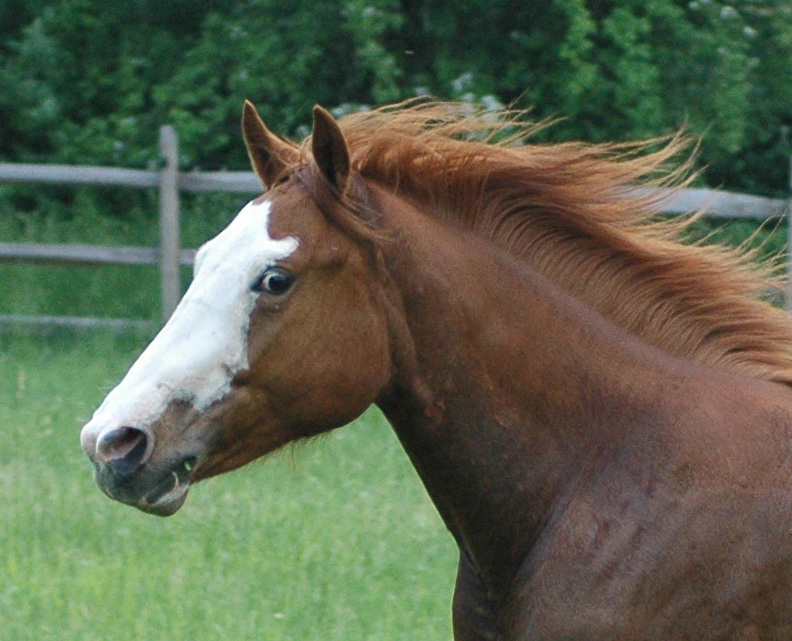
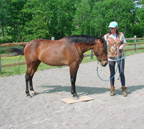
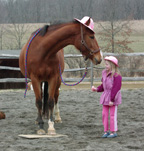
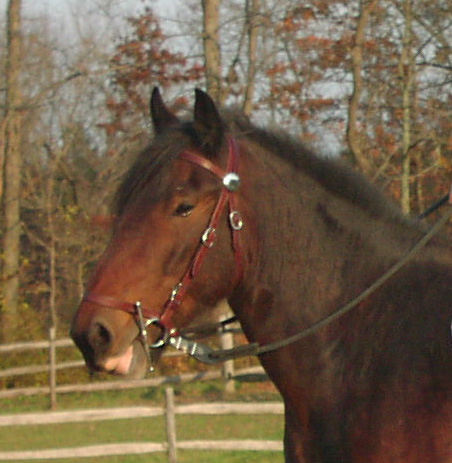
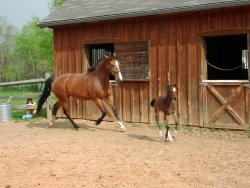 |
|
Using Clicker Training for Neurological Rehabilitation of a Horse: A Personal Account
Margaret
L. Leach (May, 2004)
Clicker training has transformed my two mares into eager, enthusiastic, highly motivated learners. My relationship with them became one of joyful partnership once we discovered how to communicate with each other, using the sound of a clicker to mark a desired response and a food treat to reward. I believe this two-way communication was an important component in the rehabilitation of my now 15-year-old mare, Serena, when she developed serious neurological problems a year ago. Using clicker training, I was better able to walk the narrow line between challenging her enough to get improvement and avoiding excessive demands that could lead to overloaded tissues, pain and possible relapse. Because Serena was so eager to clicker train, I felt confident that she had reached her limits whenever she refused to continue an activity or showed resistance during an exercise she had previously done willingly. I believe that clicker training gave her a voice that ultimately assisted in her recovery process. Based on my experiences with Serena as well as reports from other owners of horses with neurological impairment, these animals seem to have a narrower range of tolerance between enough exercise and too much exercise. They fatigue more quickly and need longer recovery times after exercise, especially in the early stages of recovery. If the trainer views resistance to a request or cue as a lack of respect or as laziness and then responds to that resistance by upping the pressure until the horse does what is asked, a neurologically impaired horse can easily be over-worked and possibly injured or pushed into relapse. I could argue this is true for a sound horse as well, but a sound horse will have greater latitudes in tolerance and better ability to recover in a timely fashion.
In my opinion, it is important to have a
relationship and a communication system that allows the horse to say “enough” or
“not yet,” especially when the horse has suffered an injury. The philosophy and
methodology of clicker training provide such a communication system. A trainer
can then make better informed training decisions. Clicker training motivated Serena so much that, as long as she felt physically able, she was eager to do more training. She seemed to view her rehabilitation program as a wonderful game to play, rather than something to be endured.
I would like to share Serena’s story of neurological challenge and her rehabilitation so you can see how clicker training aided her recovery.
PART I: Serena’s Diagnosis and Treatment
On May 5, 2003, as I led Serena, my Quarter Horse mare, out of her stall she lurched to the right, almost falling. My heart seemed to climb into my throat as I watched her continue on down the aisle, her rolling gait resembling that of a drunken sailor. With rising anxiety, I flashed back to the previous day, recalling how she had almost fallen over when I was cleaning her left hind foot. At the time I had dismissed it as a temporary loss of balance. Today’s change in co-ordination and balance, however, was impossible to dismiss.
My heart pounding, I released Serena into the arena and watched from the gate as she made her way toward a small pile of hay. As she swung her hindquarters in a turn, her entire hind end seemed to give way. I felt rising panic. It looked like she was falling backwards onto her rump. She managed to heave herself forward over her front legs and back up to standing, resolutely grabbing a mouthful of hay. Trying to fight back tears, I told myself that it was a good sign she was still interested in food. The thought did little to calm the fear flooding my entire being.
I ran to the tack room’s phone and called my vet who, thankfully, arrived at the barn within an hour. As I watched the neurological examination, my mind raced. The expression on the vet’s face told me that the news was not good
Serena now stood quietly in the barn aisle although she had exhibited unusual anxiety during the vet’s exam. While stroking Serena’s neck, I told the vet about the spook in the arena that had occurred a day or two before, seemingly triggered by a sparrow flying through a door at the far end of the barn. I commented too on how unusual it was for Serena to have such a huge response to something she normally ignored. In the past, not even dogs flying down aisles or cats dropping off ledges could prompt Serena to react in fear. As I stood beside Serena, I tried to remember when it was that I had seen her spook. Was it the day before or two days ago? I wasn’t sure.
I could still vividly recall that episode of spooking. I had released Serena into the arena but she had circled around and was approaching me, the arena wall directly behind her. Suddenly a bird flew out the far arena door, seeming to launch Serena into a huge spook. Imprinted on my brain forever is the image of energy flowing forward out of Serena’s powerful hindquarters as she leapt forward toward me. In a desperate attempt to avoid clipping me with her shoulder she immediately sucked back through her forequarters, twisting her neck and shoulders to the right. I witnessed the opposing energies colliding in her neck as she managed to avoid slamming into me.
Once a halter horse champion, Serena still looked like a weight lifter on steroids, even now, as she stood quietly at my side while I discussed her behavior with the vet. Her bulky muscles were capable of generating huge forces. Recalling this spooking episode, I was horrified by the thought that Serena might have severely injured herself while protecting me.
Pushing that awful thought from my mind, I asked the vet if Serena’s symptoms could be caused by EPM (Equine Protozoal Myeloencephelopathy). She indicated that EPM was a possibility as was some type of trauma.
The vet drew blood for testing, injected a shot of Banamine and gave me Bute to decrease inflammation. She indicated that the problem was neurological in nature and warned that Serena might recover but not be safe for riding. She said that Serena was weaker on the right side, her right hind leg being the weakest, with muscle atrophy visible in the right hip. Serena exhibited the dreaded “AAA” symptoms of EPM: ataxia, asymmetrical pattern of muscle weakness and atrophy. The vet gave me instructions for medication and hand walking as well as a warning to call her immediately if Serena’s condition worsened.
The following morning, Serena leaned more and more heavily onto her forehand during walking so that I came to feel that I was supporting her head through the halter when she had to turn. I had to be careful to keep out from under her front feet as she adopted a wide stance with her forelegs. I feared that if Serena fell, she would never get up again. The thought brought tears to my eyes but I decided to wait on calling the vet in case I was over-reacting. By that afternoon, Serena was listing to the right on the crossties, tap-tap-tapping with her hind feet when asked to back. She was clearly unsure where the ground was beneath her feet and was trying to feel her way carefully.
As soon as I saw Serena listing to the right, I called the vet. I told her that I would like Serena to go to Cornell Equine Hospital but feared that if we waited too long, we would never get her off the farm. The vet wanted to know how soon we could travel. I thought we could have the trailer ready for loading within the hour.
Loading Serena took an hour and a half because she could not lift her hind feet the few inches necessary to step up onto the trailer ramp. Finally my trainer and my husband crossed arms and supported Serena from the rear as I urged her forward from the front. Serena swayed precariously and she almost went down on the ramp, but my husband pushed his shoulder into Serena’s right hip. Together, trainer and husband heaved from behind as Serena pulled herself forward into the trailer.
After an anxious two-hour ride, we pulled up in front of the equine hospital of Cornell University in Ithaca, New York. Much to my relief, Serena was still standing. I had left her untied for fear she might hang herself if she went down. Fortunately she had always been a calm rider. She unloaded slowly and cautiously.
Two staff members greeted us and escorted us into the hospital. Serena now exhibited a high stepping gait that looked like she was marching. I tried to attribute it to the rubber mats in the hospital halls but the veterinary student shook his head no and said that it was not a good sign. After taking a history and blood samples and giving Serena a thorough neurological examination, the resident vet started an IV containing DMSO. She advised us that they would conduct a battery of tests but cautioned that sometimes, despite the many tests performed, the precise cause of the neurological symptoms could remain uncertain.
Serena stood with her front legs almost splayed, her leg bones twisting as if they no longer knew how to line up one on top of the other. She seemed calmed by the presence of my husband and myself and we were able to remain with her throughout the examination. I can cry even now when I remember the way she startled at every new sound and stood with limbs askew. Somehow she still managed to be gentle and well behaved through confusing tests and painful needle pricks.
Serena spent nine days at Cornell, undergoing a variety of tests including x-rays and a bone scan to rule out a cervical fracture. Blood work showed that Serena had been exposed to EPM at some time in her life as she had formed antibodies against the causative protozoa. However, a diagnosis of EPM cannot be confirmed by blood work alone. Only a spinal tap would show if the protozoa had reached the central nervous system.
Many horses successfully fight off the invading protozoa before they can reach the spinal cord and brain, in which case no antibodies for the organism appear in the spinal fluid. If Serena’s spinal fluid was free of the antibodies, this devastating disease could probably be ruled out as the cause of her neurological symptoms.
Even though the diagnosis of EPM was not certain, medication for it was started immediately because untreated EPM can have devastating consequences once protozoa reach the central nervous system. Whatever the cause of her neurological problems, the sooner treatment was started, the better her chances for recovery. The first few days in the hospital, her condition showed little improvement as she received DMSO, Mannitol and Vitamin E.
The spinal tap for EPM antibodies came back with a low positive result. However, the spinal fluid also showed the presence of proteins from her blood, so the results could not be considered definitive for EPM as the cause of her neurological problems. The test might be a false positive.
The veterinarian explained that if the needle used to draw out spinal fluid nicks a blood vessel on the way into the spinal canal, that blood could leak into the spinal canal and be the source of the antibodies for EPM found in the spinal fluid. The presence of certain proteins in the spinal fluid specimen can indicate such an event probably took place. Serena had those proteins in her spinal fluid as well as antibodies for EPM in both her blood and spinal fluid. The EPM antibody titer was quite low so the antibodies detected in the spinal fluid could well be from her blood and the positive test could be a false positive. We could not be sure that she had EPM on the basis of the spinal tap but we also could not entirely rule out the possibility. Being a person who appreciates clarity and certainty, I found the ambiguous test results frustrating.
After extensive testing, we still were looking at two possible causes of her neurological problems: trauma or EPM. Since she had begun treatment for both diagnostic possibilities when admitted to the equine hospital, we could only wait and hope that the medications would work.
When we went to visit Serena a few days after admission, she was big-eyed with pleasure at our arrival. She reached out with her nose and gently touched the backs of our hands in greeting through the bars of her stall. We weren’t allowed to go in with her because she still was emitting radiation from the bone scan. We stood outside her stall, forced to be content with simply looking at her.
By the third day Serena showed improvement on her neurological exam and by the fifth day the attending veterinarian jubilantly reported that Serena was at least fifty percent better. Serena continued to improve day by day. Her improving status was evident in her erect posture and the absence of the profound anxiety and reactivity to noise that had marked her admission to the hospital. She no longer was exhibiting loss of control of her hindquarters when turning. I had to agree with her student caretaker’s assessment. He had written “Serena, Superstar!” on the chalkboard outside the stall.
During our second visit to Serena, the staff encouraged us to take her for a short walk outside. She relished eating the lush green grass that grew along the building. I groomed her in the afternoon sun, taking much pleasure in restoring the coppery sheen of her coat. I was pleased to see that she easily managed irregular footing and climbed a small incline without difficulty.
On May 13, 2003, the Equine Hospital discharged Serena with a diagnosis of neurological disease. The discharge report noted that she had been a good patient and had made good progress during her hospital stay. Serena made the trailer ride home with her usual calm interest. She was clearly excited when she backed out of the trailer and could see the barn. The other horses nickered to her as she strode eagerly across the barnyard, down the aisle and into her very own stall. Tears of joy blurred my vision when I removed her halter and dropped a carrot into her feed bin. Serena was home at last.
PART II: Serena’s Rehabilitation
The precise cause of Serena’s neurological problems was still uncertain although both my local vet and the attending vet at Cornell leaned toward a spinal cord injury as the most likely cause of her rapid deterioration and speedy recovery. I was told that her fast improvement was not typical of horses with EPM. However, because she had a positive antibody titer for EPM in both blood and spinal fluid, we administered two month-long courses of Marquis, a medication used to treat EPM.
Besides the medication, I launched a neurological rehabilitation program for Serena with the hope that carefully structured exercise would further improve her balance and coordination as well as restoring strength and endurance. Happily Serena had forgotten none of her former clicker training lessons and was eager to train, despite her physical limitations. In the early stage of recovery, I chose to begin Serena’s rehabilitation by working on proprioception and co-ordination. Simply put, proprioception allows a horse to know where its body parts are in space. Catching toes, knuckling over, difficulty coordinating movement, and bumping into objects can all be symptoms of problems in the proprioceptive system. Serena exhibited all of these symptoms as well as walking with a slow, ponderous gait. She stood with her weight heavily on her forehand and her front legs spread wider than normal.
I began by having her practice standing square, placing her feet on a mat with
limbs precisely lined up directly under her, or as precisely as she could
muster. I would ask her to position her feet and click any improvements in her
alignment as she experimented with positioning each hoof when cued. The click
allowed me to say, “yes, that is what I want.” She became better and better at
Standing Square with the click providing feedback for the desired alignment.
Observing Serena trot and canter became a useful way to monitor gait deficits
and see improvements in coordination. In this initial stage, I checked her
canter only once a week because this gait was so challenging for her.
Then I introduced the challenge of speed into the training. I began walking at a brisker pace to and from turnout, click/rewarding Serena every time her nose appeared at my shoulder. She gradually progressed from lumbering along a few steps behind me to briskly walking with nose at my shoulder. I asked for longer periods of trotting and cantering during her lunging sessions.
I asked for frequent transitions. Initially Serena had trouble stopping
quickly. From my perspective, it looked like she could plant her hoof faster
than she could decelerate her cannon bone. At times, she would catch a toe of a
front hoof or “knuckle over” onto a rear hoof when she tried to stop or change
directions too quickly. Occasionally she was curling over onto the top of her
hoof and sometimes a portion of the leg when she stopped. This was painful to
watch and I always feared injury. In the more advanced stage of recovery, our current one, I began to routinely ask for and reward brisk motion as much as possible during our activities together. In previous stages I had adapted my pace to hers at least some of the time. Now I asked her to meet my energy and pace. She still worked predominantly at walk and trot but did some work at the canter. Transitions included walk/trot, trot/walk or trot/halt, trot/canter and canter/trot.
It seemed to me that the round penning with her at liberty was key in restoring
her ability to “dance,” to move fluidly and with precise control. Emphasis was
on quality of movement. I clicked and rewarded moments of self-carriage and
balance in her gaits. We spent more time on turns, moving from inside turn to
inside turn until she could do them smoothly and without hesitation, even at the
trot. Clicker training has changed the life of both of my horses in many wonderful ways. One small step at a time we have achieved goals that once seemed difficult and remote. Despite the unexpected blow of Serena’s neurological challenges, I look to the future with much hope and continue to experience the joy of clicker training with both Serena and Meadowlark.
Here she is the summer of 2004
Home | Articles | Clicker Basics | Community | FAQ | Getting Started | Horse Stories | Links | Photos | Resources
|
||||
